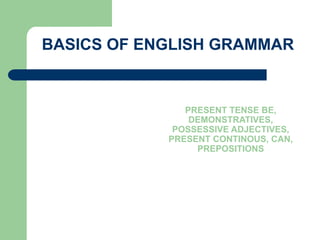
Slides Grammar.pdf
- 1. BASICS OF ENGLISH GRAMMAR PRESENT TENSE BE, DEMONSTRATIVES, POSSESSIVE ADJECTIVES, PRESENT CONTINOUS, CAN, PREPOSITIONS
- 2. PRESENT TENSE BE ●The verb BE has three forms: AM, IS, ARE, which we have to use according to the pronoun or subject. TO BE Occup ations Nouns Adjecti ves Places
- 3. AFFIRMATIVE SENTENCES They are doctors. ARE They We are friends. ARE We It is a city. IS It She is my sister. IS She He is in the lab. IS He You are a student. ARE You I am a teacher. AM I Example Verb Form Subject
- 4. NEGATIVE SENTENCES You can make negative sentences similar to the sentences before. The only different is to add NOT after am, is, are, as you can see in the following chart. She is not sad They are not in the school
- 5. NEGATIVE SENTENCES We’re not = We aren’t You’re not = You aren’t They’re not = They aren’t We You are not They He`s not = He isn’t She’s not = She isn’t It’s not = It isn’t He She is not It I`m not I am not
- 6. REVIEW Are they doctors? Are we friends? Is it a city? Is she my sister? Is he in the lab? Are you a student? Am I a teacher? Yes/No Question They are not doctors. We are not friends. It is not a city. She is not my sister. He is not in the lab. You are not a student. I am not a teacher. Negative Statements Yes, they are / No they are not They are doctors. Yes, we are / No, we are not We are friends. Yes, it is / No, it is not It is a city. Yes, she is / No, she is not She is my sister. Yes, he is / No, he is not He is in the lab. Yes, I am / No, I am not You are a student. Yes, you are / No, you are not I am a teacher. Short Answers Statement
- 7. POSSESSIVE ADJECTIVES I My You Your He His She Her + It Its We Our They Their NOUN
- 8. POSSESSIVE ADJTECTIVES This is our house Her pants are blue His shirt is new This is her cat
- 9. POSSESSIVE FORM ‘S Kevin’s wife is Rose. His wife is Rose. Charlie’s book is black. The Child’s mother is happy
- 10. PREPOSITION OF PLACE At the bus station at home At the door at the top At work at the end of AT (lugar específico) On a shelf on a wall On a plate on the table On a balcony on a door ON (sobre una superficie) In the house in a shop In a room in a town In a car in a garden IN (dentro de)
- 11. PRESENT CONTINOUS ●The present continous tense is used to describe activities that happen now, that means activities that are develop in the moment of speaking Singing Are We You They Singing Is He She It Singing Am I -ING FORM BE Subject
- 12. PRESENT CONTINOUS They are not studying We are not walking It is not running She is not reading He is not sleeping You are not eating I am not dancing NEGATIVE Are they studying? They are studying Are we walking? We are walking Is it running? It is running Is she reading? She is reading Is he sleeping? He is sleeping Are you eating? You are eating Am I dancing? I am dancing YES/NO QUESTIONS AFFIRMATIVE
- 13. RULES coming lose - losing live – living Remove E, then add –INGcome 1 vowel + 1 consonant + E- swim - swimming hit - hitting get – getting Double the consonant, then add –ING 1 vowel + 1 consonant Examples How to make the -ING form Verb ending in... say - saying go - going walk - walking Add –ING [anything else]